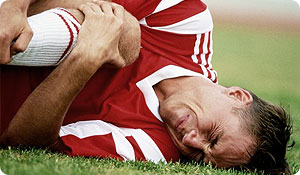
Since Tom Brady and other high-profile athletes have been sidelined with a sports hernia, there's been greater awareness of this sports injury. Every year there are about 35 to 40 million injury-related emergency room visits--approximately 10 percent are sports related, reports American Sports Data. However, you're probably more familiar with sports injury terms such as "concussion," "ACL tear" and "pulled hamstring." But it's increasingly common for athletes and physically active people--old and young--to develop sports hernias.
In some circles the term sports hernia is considered erroneous, because unlike a real hernia, there's no bulge in the muscle tissue. For this reason, a sports hernia is also referred to as an "athletic pubalgia," because it causes pain in the pubis or front pelvic bone and is largely sports related.
The University of Maryland Medical Center describes a sports hernia as a small, inguinal hernia in which the abdominal wall muscles weaken or tear and cause pain in the groin area. You're more susceptible if you're involved in a sport or activity that has a lot of twisting and turning motions. Footballers, hockey, soccer and tennis players are the likely victims, but it can also affect runners, hurdlers and skiers.
According to John H. Wilckens, M.D., director of orthopedics at the Johns Hopkins Bayview Medical Center, a sports hernia may be due to overuse of the thigh and lower abdominal muscles that results in the weakness or tear. However, it's often under-diagnosed because many with the condition just think that they have chronic pain.
Symptoms of a Sports Hernia
Sports hernia symptoms may mimic other conditions, such as a strained abdominal muscle. They're usually on one side of your groin area and increase gradually. The Washington University School of Medicine indicates that symptoms of a sports hernia are usually felt during exertion. So you may not notice any pain when sitting or walking, but you won't miss the signs when you're in a full stride or running, for instance.
Sports Hernia Diagnosis
Diagnosing a sports hernia can be tricky because of the fact that it shares symptoms with some other lower abdominal injuries. Common diagnostic tests such as MRIs, X-rays, CT-scan and ultrasound may not be specific enough to provide information about sports hernias, due to complex anatomy and biomechanical considerations that accompany this injury, says Dr. Wilckens.
The most reliable diagnosis of this sports injury is exploratory surgery, says Wilckens, but he adds that there are some tests that may rule out other possible conditions:
- a complete training history
- observation of specific movements during a sport
- a physical exam that includes palpation, range of motion and motor testing
- a check for muscle tears, strains, bone inflammation, stress factors, bursitis and osteonecrosis
- pain levels during quick movements such as twisting, turning, running and bending forward, or pain in the scrotum, hip and back
Treatment for a Sports Hernia
Rest and ice is usually the first treatment prescribed for a sports hernia. This could last as long as a few weeks or a few months. During that time you may also have to take anti-inflammatory drugs. Physical therapy--massage, stretching, core strengthening and stabilizing the hip and pelvic areas--may also provide relief.
If these more conservative treatments remedy your sports hernia, surgery may be your only option. Studies show that surgery followed by a rehabilitation program can successfully treat most cases of this sports injury.





